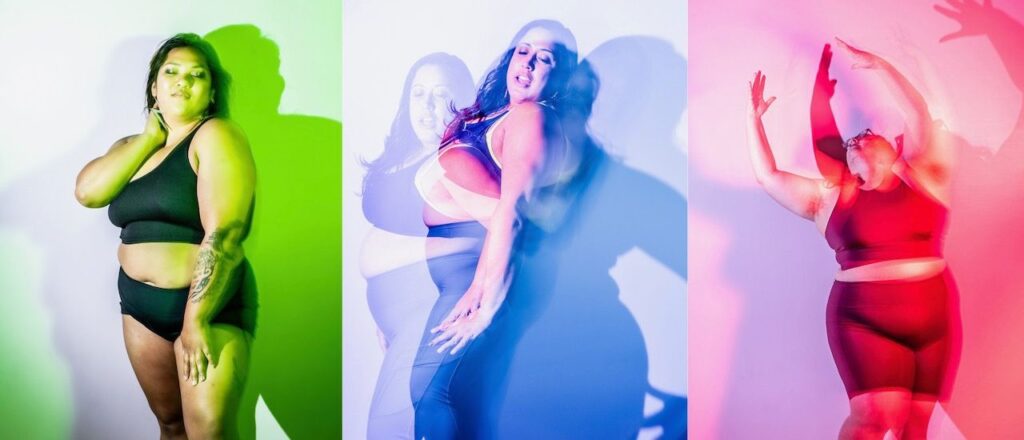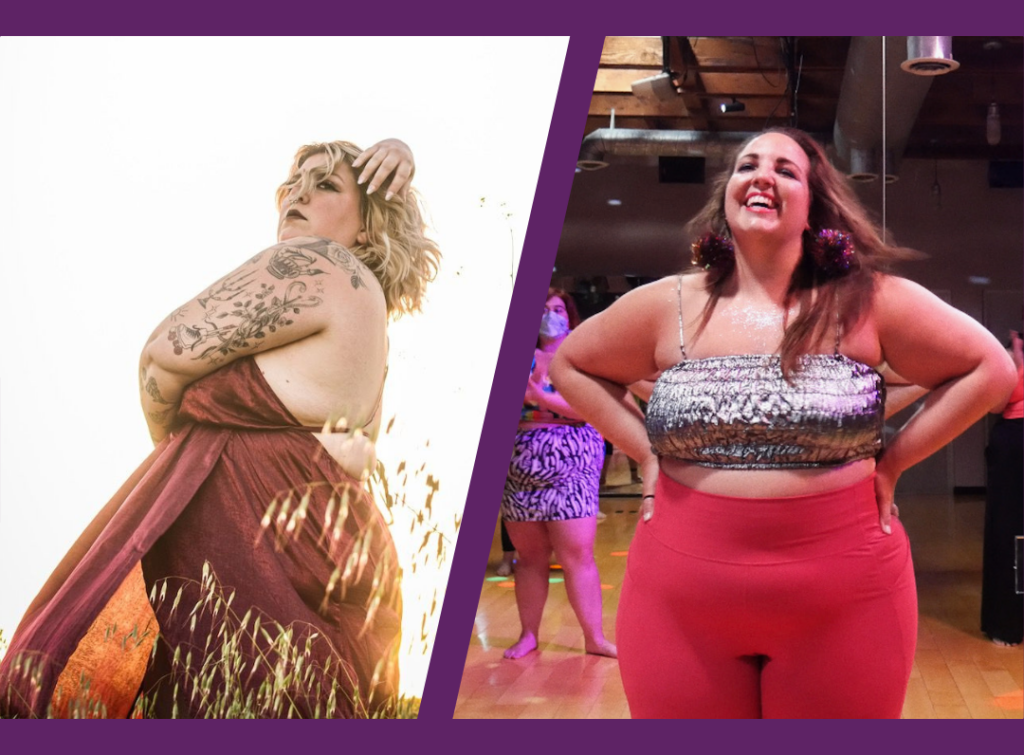
Photo by Isabelle Duffy
[ID: Six fat-identified dancers wearing bright, colorful clothes, dancing in a dark studio with colorful disco party lights reflecting on the walls and floor. The dancers have their hands up as if putting imaginary crowns on their heads.]
Editor’s Note: Kat Koenemann is Dancers’ Group’s General Manager and Alex Tiscareno is a Dancers’ Group Administrative Assistant. Their paths crossed through their fat-positive advocacy.
Content notice: Includes references to anti-fat bias and eating disorders. If you or someone you love may be suffering from an eating disorder, go to nationaleatingdisorders.org/help-support for support.
KAT: I’m so excited we’re working together at Dancers’ Group. It’s wonderful to meet another dancer/teacher in a bigger body who is also making space for bigger bodies in dance. I identify as a fat dancer. I use “fat” in a neutral, even positive way, and it’s been liberating. The word can carry a lot of weight (pun intended), but our discomfort with the word “fat” can be illuminating!
ALEX: It’s really nice to see dancers who have a similar body type to me. I’ve always identified as plus-size or bigger-bodied. More recently, I opened up to describing myself as a fat dancer once I started my thesis work, which, as you know, was about how anti-fatness affects the dancing body.
KAT: That is such important work! I have also shifted from body positivity and trying to “love my body” to confronting anti-fatness and seeing the bigger picture: ALL bodies deserve respect regardless of size, skin color, ethnic background, gender, sexuality, age, health or ability status. It’s not just about self-love, it’s about human rights. We’ve been treating fat people terribly, and weight-stigma intersects with other marginalizations to keep people disempowered.
ALEX: Absolutely! For a long time I hated my body because of the hatred I experienced in dance spaces; it took its toll. During my research, I read the book Belly of the Beast: The Politics of Anti-Fatness as Anti-Blackness by Da’Shaun L. Harrison. In it, they reject this idea that loving yourself will solve anti-fatness. They describe the body-positivity movement as a mask to the violent idea of thinness, robbing us of fat liberation. This stuck with me.
KAT: We’re told to love ourselves, but with conditions!
ALEX: Exactly! Dancers are subjected to high rates of disordered eating, so as I worked though my own relationship with food and my body, I began to examine my own internalized fatphobia. It made me want to share the stories of myself and others, which is why I opted to use interviews of dancers in bigger bodies within my thesis work. Fat dancers often are discredited when we draw from the fatphobic treatment we’ve received. I wanted to show that this treatment is still prevalent within the dance community. It’s great to connect with you, because you are actively fighting for fat liberation and joy in dance. Can you say more about what you do?
KAT: I teach weekly classes at Hipline studio in Oakland. They are low impact, high energy, follow-along dance classes that center expression and joy. I’m also the studio’s Body Empowerment Consultant, helping our studio follow through on our commitment to combat anti-fatness and empower bodies of all shapes and sizes.
ALEX: That is wonderful!
KAT: I also teach a monthly dance class for fat-identified folks called Big Thick Energy, which started in July of 2022. I was afraid no one would show up, but every class has been packed, with a waitlist! The class has been such a joyful and healing space. It’s been transformative for the dance studio. We now have more body diversity in all the classes. It’s beautiful!
ALEX: I completely agree. We need more dance spaces that actively commit to making this radical transformation. Da’Shaun L. Harrison writes, “In order to destroy anti-fatness and anti-Blackness, we must destroy Desire, Beauty, Thinness and Whiteness.” They are referring to the meaning that society assigns to each of these words and who benefits from them—white, cis-gendered, thin and able-bodied individuals. In order to advance body inclusivity within the dance field we have to destroy this oppressive system and reimagine a world where everyone is valued equally.
Sabrina Strings wrote a book called Fearing the Black Body: The Racial Origins of Fat Phobia where she talks about how fatphobia is rooted in racism against Black bodies, particularly Black women. The Black Dancing Body, written by Brenda Dixon Gottschild, dives deeper into how this manifests and affects Black dancing bodies. These authors and texts have been crucial in my fat liberation advocacy work. I am a queer, white Latina who has been treated horribly because of the size and shape of my body. Still, it will never come close to the severity that Black and Brown bodies go through on a daily basis. My work is only scratching the surface and is only my perspective, which is still very privileged comparatively.
KAT: These are essential resources. I also have privilege as a white, cis-gendered, mostly able-bodied person. Even my relative size as a 2x/3x woman gives me privilege over larger fat folks. We should all be listening to and learning from people in the most marginalized bodies. Larger fat, Black, Brown, Indigenous, Disabled and Queer activists have been doing this work for a long time.
ALEX: Absolutely.
KAT: It’s not a coincidence that the most anti-fatness I’ve experienced in dance has been in very White spaces, where the emphasis was on perfectionism, uniformity, and strict technique—all values rooted in White supremacy. A big part of this work is re-evaluating what we merit in dance. I don’t want to see dancers that look exactly alike with the same body type and technique. I want to see authenticity, creativity, embodiment, joy and expression.

ALEX: I’m glad you mentioned embodiment. There is this big push in the dance community for more embodied practices like somatics, a field of movement practices that emphasizes internal physical perception and experience. However, when you look at who is getting credit for this idea, it’s white individuals. These practices are not new. Black, Indigenous and other People of Color have been practicing “embodiment” for centuries. Dance has given us a “codified” method of healing but it is still a luxury that is afforded to white, cis-gendered, able-bodied individuals. I’ve written about how I think this could be radically overhauled in my thesis. What have you noticed in your work about how we, as individuals who benefit from this system, can begin to dismantle it?
KAT: Wow. That is real. “Embodiment” should be our natural state! In a capitalist system so much is taken and sold back to people. Our bodies become projects that are never complete, and the powerful tool that disempowers us from opting out of these systems is shame. It’s overwhelming to fight an entire system, but we can begin with ourselves. We start by unlearning the idea that some bodies are more valuable or morally better than others.
In a dance studio, owners, directors, teachers, choreographers, and staff need to be doing intentional work to challenge their own biases, including anti-fat bias, as well as offering resources and training for staff and dancers. In addition, a crucial safety measure for all movement spaces is to educate about eating disorders. They are more common and dangerous than folks realize, and they affect people of all sizes.
I strongly suggest keeping diet-talk and negative body talk out of the dance space. Conversations about personal eating choices (weight-centric or not) can be reserved for elsewhere. Any body talk that uplifts certain bodies or characteristics over others shouldn’t be allowed, including comments about oneself. It’s understandable to have critical thoughts about our bodies, but these should be processed privately, with consent—let’s keep it out of dance space.
ALEX: This type of talk is prevalent!
KAT: It is everywhere! I take a trauma-aware approach. I assume anyone entering my class may have trauma related to their body image—especially fat folks. So I go out of my way to emphasize non-judgement, to center the dancers’ experience. I provide options for dancers to customize movement to their body and remind them that they are the owners and executors of their own body.
As we look at our dance spaces through this lens, we can ask: Who is not here, and why? Are the movements accessible or adaptable? Is there fat-friendly seating in the studio? Is the building accessible? Are the costumes or merchandise available in inclusive sizing? Is there body-diversity in marketing materials? Are there other types of diversity in the space (ethnicity, race, gender expression, sexuality, age, ability)? Will people of all shapes and sizes feel comfortable and included?
Our society is anti-fat, so our spaces will be, too, unless we work on it. We won’t be perfect, but we should start somewhere.
ALEX: I was “raised” in modern and contemporary performance spaces, so these values hold a lot of weight to me. I was always told that because I was fat, I would never be a professional dancer or that I would make companies look “trashy.” I was encouraged to get weight loss surgery and graphically told how disordered eating would benefit me and make me “hireable”. Even in the Bay Area, people have told me that not all inclusion is good inclusion and that “fat dancers just can’t do what other dancers can do.”
KAT: First of all, I am so sorry those things were said to you. It’s unacceptable. I’m glad it didn’t stop you from dancing because we both know that fat dancers absolutely CAN dance.
ALEX: Yes! That is why I’ve pulled my focus more towards the performance side of dance. You don’t often see larger dancers on stage, working with professional companies, or getting recognized by notable choreographers. Someone once told me that they saw a “bigger dancer” dancing for Bill T. Jones and they felt that was enough representation. One time with one dancer isn’t enough. Why is dance hesitant to be body inclusive? Why is dance adamant on continuing archaic body standards—especially when it doesn’t match the collective society it exists in, you know?
KAT: YES. So many dancers I work with tell me they never even made it to the point of an audition because of negative experiences and internalized anti-fatness. I even quit dancing several times.
How many amazing dancers is the world missing out on?
ALEX: Absolutely. I would love to see bigger bodied dancers in a professional setting. I look back at the younger me who felt so alone. I think about what seeing people who looked like me would have done for my experience and mental health. There is an active disconnect between mission statements and the representation we see in these settings. Companies can’t, in good faith, say they are advocating for diversity, equity and inclusion while not including different body types in that advocacy. It shows that there is a lot of work that still needs to be done. It’s not just harming dancers with bigger bodies; it’s hurting everyone who participates in dance.
KAT: That is the magic of this work: It helps liberate everyone. Every person with a body deserves to live fully and joyfully without shame. And I know that for both of us, a full and joyous life includes dancing.

Right: Kat Koenemann, photo by Isabelle Duffy. [ID: Kat, a white, fat-identified dance teacher, wearing pink leggings, a silver crop top, with her hands on her hips, smiling wide, standing in front of a mirror in a dance studio, with the reflection of two dancers on either side of her.]
Alex (she/they) is a plus-sized dance artist from Fresno, CA. Since starting her dance education in 2012, Alex has made it her mission to advocate for body inclusivity in professional dance spaces. Recently she obtained her MFA and is currently setting work with her company Aleño Dance Project.


